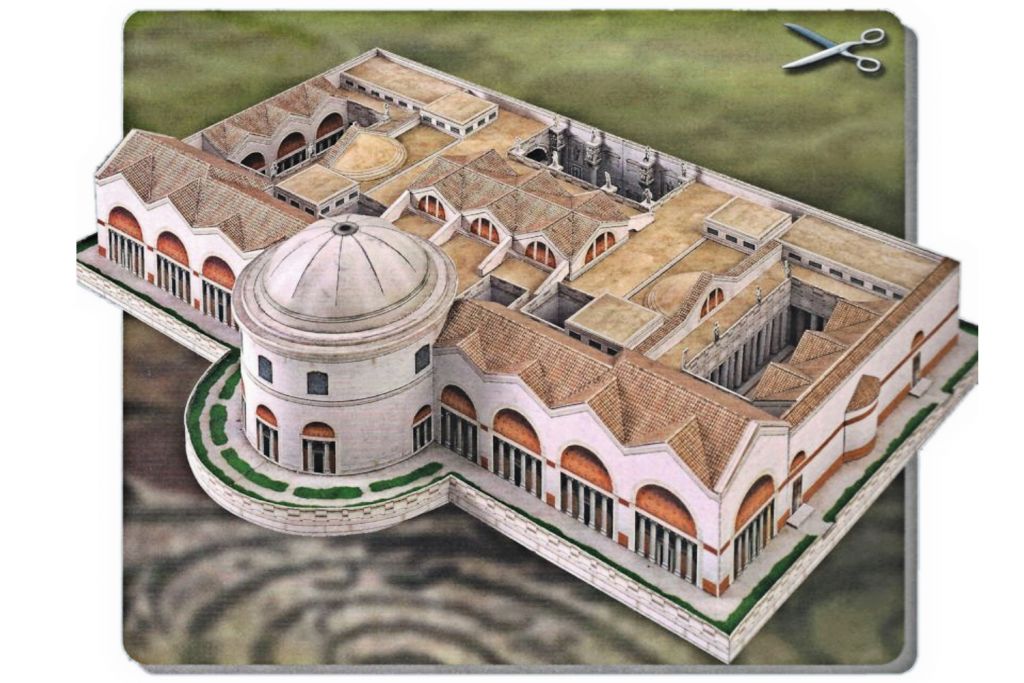Baths of Caracalla, Rome 1:600
Model kit of the reconstructed baths of Caracalla in Rome, cardboard. Scale 1:600, Size 40 x 28 x 10 cm. The dome of the Caldarium and another roof can be taken off to make the interior visible.
Baths of Caracalla, Rome 1:600
Model kit of the reconstructed baths of Caracalla in Rome made from cardboard. Scale 1:600, Size 40 x 28 x 10 cm. Difficulty 3 of 4 (moderate difficulty), consisting of 10 cardboard sheets. The dome of the Caldarium and another roof can be taken off to have a look at the interior furnishing. The parts have to be cut out with scissors, folded and glued.
Baths of Caracalla in Rome
The Baths of Caracalla ranked among the largest public baths in Rome. Construction was begun in the year AD 206 and completed in AD 216, during the reign of Emperor Caracalla. Further extensions and embellishments were added until the year 235. The baths were in use for over three centuries. During a siege in the year 536, the Goths destroyed the aqueduct that was responsible for the water supply of the complex. After further destruction by an earthquake, the complex deteriorated and served as a quarry. The ruins of the baths were used, among other things, as building material for newly arising villas.
The baths were situated on the Aventine Hill. A huge terrace-shaped platform was constructed in order to make room for the complex. This covered approximately 11 hectares (approx. 27 acres). The bath house was situated roughly in the centre of the complex. In the surrounding buildings the libraries, restaurants, gymnasiums, art galleries and more were located. The baths, therefore, were not merely a bathing complex but more like a large leisure centre. It is probable that 1,600 to 2,000 visitors used the baths daily. The complex was heated by huge wood-fired furnaces in an underground tunnel system.
The main building was divided into two side wings with the same design. The allocation of the rooms was according to the procedure of the Roman bathing ritual. First one entered the changing room (Apodyterium), where one took off one’s clothes and placed them in cubicles or on shelves, where slaves looked after the visitors’ belongings. The visitors then washed the dust from their feet in a small water basin before entering the next rooms. In the Tepidarium the visitors could be massaged and anointed by slaves. In the next room, the Caldarium, there were several warm-water basins where the guests could sit and relax. Then came the Sudatorium, a steam bath which was isolated from the outside – comparable to today’s sauna. After the steam bath the visitors went into the cold-water basin (Frigidarium), which was large enough for swimming. An outdoor pool (Piscina) could also be used for this purpose.
Many Roman households didn’t have a bath of their own. Visiting the public baths was therefore also of great importance for hygienic reasons. Bathing also served medical purposes. The Greek physician Hippocrates discovered warm-water baths and gushes of cold water to be a therapy for sick people. This knowledge came to Rome through Greek prisoners of war and slaves. For example, in Roman baths, steam baths, mud therapies and swimming were used as therapeutic measures to cure insomnia, headaches, colds, liver and joint disease.
In addition to personal hygiene and medicine, thermal baths were of great social importance. Many Romans stayed in the public baths for several hours in order to meet friends and relatives, but also to make political agreements with fellow party members or to conclude contracts. Many writers are said to have made use of a visit to the public baths in order to read their works to other bathing guests.
| Delivery time | 1-2 weeks |
|---|---|
| weight | 0.600000 |
| size | 40 x 28 x 10 cm |
| Scale | 1:600 |
| Level of difficulty | 2 - medium |
| Type of model | Building |
| Era | Romans |
| Material | Cardboard |

